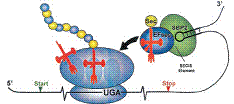Biochemistry, Department of

Vadim Gladyshev Publications
Document Type
Article
Date of this Version
June 1996
Abstract
The possible relationship of selenium to immunological function which has been suggested for decades was investigated in studies on selenuim metabolism in human T cells. One of the major 75Se-labeled selenoproteins detected was purified to homogeneity and shown to be a homodimer of 55-kDa subunits. Each subunit contained about 1 FAD and at least 0.74 Se. This protein proved to be thioredoxin reductase (TR) on the basis of its catalytic activities, cross-reactivity with anti-rat liver TR antibodies, and sequence identities of several tryptic peptides with the published deduced sequence of human placental TR. Physicochemical characteristics of T-cell TR were similar to those of a selenocysteine (Secys)- containing TR recently isolated from human lung adenocarcinoma cells. The sequence of a 12-residue 75Se-labeled tryptic peptide from T-cell TR was identical with a C-terminaldeduced sequence of human placental TR except that Secys was present in the position corresponding to TGA, previously thought to be the termination codon, and this was followed by Gly-499, the actual C-terminal amino acid. The presence of the unusual conserved Cys-Secys-Gly sequence at the C terminus of TR in addition to the redox active cysteines of the Cys-Val- Asn-Val-Gly-Cys motif in the FAD-binding region may account for the peroxidase activity and the relatively low substrate specificity of mammalian TRs. The finding that T-cell TR is a selenoenzyme that contains Se in a conserved Cterminal region provides another example of the role of selenium in a major antioxidant enzyme system (i.e., thioredoxin- thioredoxin reductase), in addition to the well-known glutathione peroxidase enzyme system.


Comments
Published in Proc. Natl. Acad. Sci. USA Vol. 93, pp. 6146-6151, June 1996 Biochemistry. Permission to use.